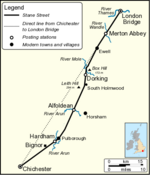High Weald AONB
Areas of Outstanding Natural Beauty in EnglandProtected areas established in 1983Protected areas of East SussexProtected areas of KentProtected areas of Surrey ... and 1 more
Protected areas of West Sussex

The High Weald Area of Outstanding Natural Beauty is in south-east England. Covering an area of 1,450 square kilometres (560 sq mi), it takes up parts of Kent, Surrey, East Sussex, and West Sussex. It is the fourth largest Area of Outstanding Natural Beauty (AONB) in England and Wales. It has an attractive landscape with a mosaic of small farms and woodlands, historic parks, sunken lanes and ridge-top villages. The area consists of 99 parishes and a total population of approximately 120,000 persons. The main communities are Royal Tunbridge Wells, Crowborough, Hastings and Haywards Heath.
Excerpt from the Wikipedia article High Weald AONB (License: CC BY-SA 3.0, Authors, Images).High Weald AONB
Furzen Lane, Mole Valley Abinger
Geographical coordinates (GPS) Address Nearby Places Show on map
Geographical coordinates (GPS)
| Latitude | Longitude |
|---|---|
| N 51.112 ° | E -0.411 ° |
Address
Furzen Lane
Furzen Lane
RH12 3AR Mole Valley, Abinger
England, United Kingdom
Open on Google Maps








